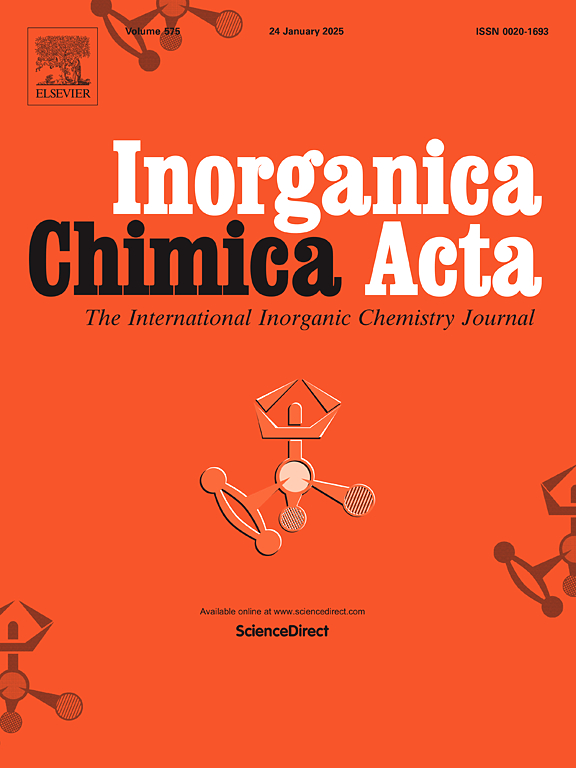Porphyrins functionalization by alkenyl compounds using the Heck cross-coupling reaction. Insights on methodologies and reaction products
IF 2.7
3区 化学
Q2 CHEMISTRY, INORGANIC & NUCLEAR
引用次数: 0
Abstract
Porphyrins are peculiar molecules with very interesting photochemical properties, generally their absorption spectrum typically spans from 350 nm to 650 or 590 nm for the free-base or metal-complex porphyrins, respectively. This wide absorption window makes them suitable candidates for many different applications dealing with light interaction, as need in the new emerging solar cells technologies, in the non-linear optics field and in medical applications such as bioimaging and photodynamic therapy (PDT). By introducing substituents at the meso- or beta-pyrrole position, the porphyrin absorption spectrum can be modified according to the requirements of the different application fields. One of the most effective way to deep affect the UV–vis spectrum of porphyrins is to extend the π-electron system of the tetrapyrrole ring. This can be achieved by introducing triple or double C![]() C bonds directly connected at meso- or beta-position. However, while the introduction of a simple triple bond and, more in general, alkynes exploiting Sonogashira reaction is widely used in porphyrin chemistry affording very high yields, the introduction of a double bond or alkenyl compounds with a well-defined stereochemistry through classical reactions or palladium-catalyzed cross-coupling reactions still remains problematic in terms of hard reaction conditions, excess of alkene reagents, by-products formation. In this review we want to report the synthetic methods described in the literature for obtaining meso- and beta-functionalized porphyrins by means of coupling alkenyl derivatives with porphyrins and metalloporphyrins, thorough the use of the Heck cross-coupling reaction that, if on one hand, is well consolidated with canonical reagents (e.g. with simple aryl-halides, either bromo- or iodo-, or even aryltriflates) on the other side it can be very tricky when meso- or- beta-brominated porphyrin are used. Nevertheless the Heck cross-coupling reaction still remains one of the most versatile synthetic methodology to modify the porphyrin core and, consequently, the optical properties of the tetrapyrrole macrocycle. We will briefly discuss which results can be obtained when bromoporphyins are used as starting aryl-halide and show the last achievements of such coupling by the use of the modern palladium transmetallation reactions.
C bonds directly connected at meso- or beta-position. However, while the introduction of a simple triple bond and, more in general, alkynes exploiting Sonogashira reaction is widely used in porphyrin chemistry affording very high yields, the introduction of a double bond or alkenyl compounds with a well-defined stereochemistry through classical reactions or palladium-catalyzed cross-coupling reactions still remains problematic in terms of hard reaction conditions, excess of alkene reagents, by-products formation. In this review we want to report the synthetic methods described in the literature for obtaining meso- and beta-functionalized porphyrins by means of coupling alkenyl derivatives with porphyrins and metalloporphyrins, thorough the use of the Heck cross-coupling reaction that, if on one hand, is well consolidated with canonical reagents (e.g. with simple aryl-halides, either bromo- or iodo-, or even aryltriflates) on the other side it can be very tricky when meso- or- beta-brominated porphyrin are used. Nevertheless the Heck cross-coupling reaction still remains one of the most versatile synthetic methodology to modify the porphyrin core and, consequently, the optical properties of the tetrapyrrole macrocycle. We will briefly discuss which results can be obtained when bromoporphyins are used as starting aryl-halide and show the last achievements of such coupling by the use of the modern palladium transmetallation reactions.

求助全文
约1分钟内获得全文
求助全文
来源期刊

Inorganica Chimica Acta
化学-无机化学与核化学
CiteScore
6.00
自引率
3.60%
发文量
440
审稿时长
35 days
期刊介绍:
Inorganica Chimica Acta is an established international forum for all aspects of advanced Inorganic Chemistry. Original papers of high scientific level and interest are published in the form of Articles and Reviews.
Topics covered include:
• chemistry of the main group elements and the d- and f-block metals, including the synthesis, characterization and reactivity of coordination, organometallic, biomimetic, supramolecular coordination compounds, including associated computational studies;
• synthesis, physico-chemical properties, applications of molecule-based nano-scaled clusters and nanomaterials designed using the principles of coordination chemistry, as well as coordination polymers (CPs), metal-organic frameworks (MOFs), metal-organic polyhedra (MPOs);
• reaction mechanisms and physico-chemical investigations computational studies of metalloenzymes and their models;
• applications of inorganic compounds, metallodrugs and molecule-based materials.
Papers composed primarily of structural reports will typically not be considered for publication.
 求助内容:
求助内容: 应助结果提醒方式:
应助结果提醒方式:


